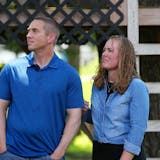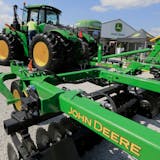The Twin Cities apartment boom has spread from the urban core to suburbia, where new buildings bedecked with amenities are reshaping neighborhoods and challenging the primacy of the single-family home.
Apartment construction has been ramping up in the suburbs, which last year collectively permitted 2.5 times more multifamily housing units than Minneapolis and St. Paul, according to new Metropolitan Council data. Not since the early 1970s, during the first wave of suburban apartment construction, have multifamily units accounted for such a large share of overall suburban development.
"This, over the last five years, has just popped up," said Pam Cecchini, who grew up in Apple Valley and recently moved back, as she looked out over Kelley Park, around which about 650 multifamily units have been approved or built across five developments since 2010. They range from a senior housing facility to luxury apartments with a private theater.
Where corn once grew on a family farm in Woodbury, more than 500 multifamily units are now rising in an "urban village." Seniors can soon enjoy what developers dub a "permanent staycation" at age-restricted housing beside Eagan's outlet mall. An undeveloped island in Minnetonka now boasts "The Island Residences," complete with canoe landing to paddle around the property.
Despite resistance in some suburban neighborhoods to dense development, the apartment boom is forecast to continue. Marquette Advisors estimates that the share of the metro area's apartments opening in the suburbs will rise from about half this year to 73 percent in 2019, before falling back to 54 percent in 2020. The suburbs account for about three-quarters of the metro area's population.
"It used to be a safe assumption that multifamily development was only happening in the core cities or the oldest parts of the region, or on a transit line," said Libby Starling, the Met Council's deputy director of community development.
One recent evening, workers were busy installing the "lazy river" at Talo apartments in Golden Valley on what was once spare state-owned right of way off Interstate Hwy. 394. The property, still under construction, features a two-story gym with a rock climbing wall among other amenities, such as a "speakeasy" lounge hidden behind a bookshelf.
"It's away from the mess of Uptown, away from the clutter," said Daniel Colvin, a 29-year-old financial planner who recently moved into the property.



